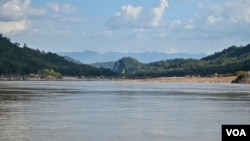Laos has dismissed fears that its next hydropower dam on the Mekong River would devastate downstream communities after neighboring countries and rights groups raised their doubts at a regional forum in the capital last week.
The tiny landlocked country announced its intentions to go ahead with the 1,460 MW Luang Prabang dam in July, making it the fifth of nine dams it has planned for the waterway to move forward — and the largest yet — in its bid to become "Asia's battery." The first, the Xayaburi, began operating late last month.
Environmental rights groups are warning that the dams will kill off much of the fish stocks millions of people depend on for a living and hold back the vital sediment flows the Mekong delta — Vietnam's rice bowl — needs to rejuvenate. Some of them have urged Laos to cancel its latest project.
Undeterred, Laos officials at last week's forum in Vientiane said the government was taking steps to minimize the damage.
Vithounlabandid Thoummabout, deputy secretary general of the Energy and Mines Ministry's energy policy and planning department, said the country was drawing on its experience from the Xayaburi, where fish passes were working "as expected."
He said the Luang Prabang would feature two fish locks to help migrating species swim upstream as well as a ship lock they could also use, and seven "fish friendly" turbines.
Gates in the dam would also "maintain similar sediment concentration as in natural conditions," he added.
Like many of the country's dams, the Luang Prabang is being built mostly by and for Laos' neighbors, in this case Vietnam. The state-owned PetroVietnam Power Company holds the largest share, and most of the energy it churns out starting 2027 is destined for Vietnam and Thailand. Construction is scheduled to start next year.
Yet even Vietnam, whose stretch of the Mekong runs downstream from Laos, has its doubts about the Luang Prabang.
"As a fisheries expert, I'm still not sure [if] some kinds of fish passes work or not. So for me I think there should be more ... researching whether it works," said Hoang Van Cuong, of that state-run Vietnam Institute of Fisheries, Economics and Planning.
The forum was organized by the Mekong River Commission, a body comprising state officials from the four countries that share the lower Mekong — Cambodia, Laos, Thailand and Vietnam — meant to manage the river's development to their mutual benefit.
So Nam, the MRC secretariat's chief environmental management officer, said the Xayaburi's fish passes were still being studies but added that few of the passes he has reviewed at dam sites around the world have managed to prevent a drop in fish numbers.
"After 30 years it comes back in terms of the [fish] bio-diversity, but in terms of abundance is another question," he said.
The forum was part of a six-month "prior consultation process" for the Luang Prabang dam that started October 8 during which Laos will share its plans and its fellow MRC members can raise concerns.
Many question not only the dam, but the consultation process itself.
Kol Vathana, deputy secretary general of the Cambodia National Mekong Committee, complained that the lack of project documents translated into Cambodian left many shut out of the process and that six months was not enough.
"So I think we should have the documents before the starting date of the six-month process. Then we can deliver [the] documents to other stakeholder target groups, so they have time enough to review, to understand. If they don't understand the project documents, for sure they will not have the right input," he said.
Rights groups have been complaining for years that the process leaves the rural communities likely to be hit hardest by the dams mostly left out, and that Laos has largely ignored its neighbors' concerns. The government has ignored requests to extend the consultations for prior dam projects.
"Process is process, but we need the end result," said Te Navuth, permanent vice-chairman of the Cambodia National Mekong Committee and his country's representative to the MRC's joint committee.
He said he wanted to see "what has changed after six months of consultation, what is different, changed, before and after."
So Nam and other MRC experts said the plans Laos submitted for the Luang Prabang dam were also short on key details on several fronts, from its potential ecological impacts to the effects of lost fish spawning grounds, how the turbines would actually prove "fish friendly," and compensation for hard-hit communities.
Pressed on the dearth of details, Laos National Mekong Committee Secretary General Chanthanet Boualapha said his government was striving to do better.
"Of course we are not perfect. What is perfect? So we try to improve ourselves," he said.
"I believe that in the [prior consultation process] we can get much ideas, comment, experience, expertise from you so that we can improve the Luang Prabang project," he told the audience. "I don't want [the] next generation to blame me in 20 or 30 years, so we do our best."any of them have yet to be convinced.







